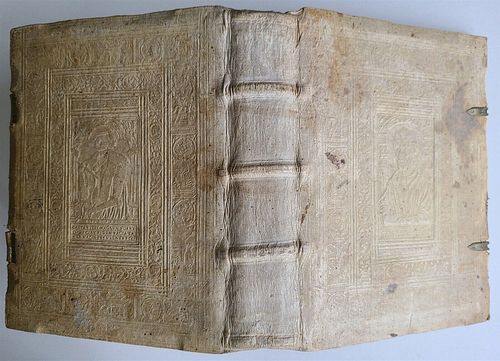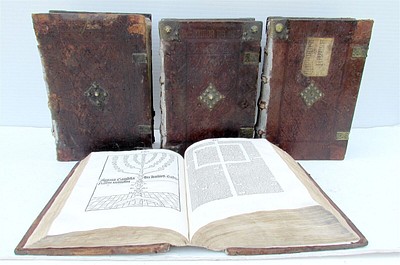GERMAN ANTIQUE 16TH-CENTURY HAND-TOOLED PIGSKIN WITH CLASPS, 1564 CHRONICA CARIONIS
Lot 207
About Seller
NY Elizabeth
269 South Beverly Drive Suite 142
Beverly Hills, CA 90212
United States
NY Elizabeth was established in 1956 as an art gallery, and is now a leading international online auction house with locations worldwide, including the United States, United Kingdom, and Sweden. NY Elizabeth specialty is art, watches, fashion, and automotive. The auction house also offers a number o...Read more
Categories
Estimate:
$1,400 - $1,600
Absentee vs Live bid
Two ways to bid:
- Leave a max absentee bid and the platform will bid on your behalf up to your maximum bid during the live auction.
- Bid live during the auction and your bids will be submitted real-time to the auctioneer.
Bid Increments
| Price | Bid Increment |
|---|---|
| $100 | $100 |
| $2,000 | $250 |
| $10,000 | $500 |
| $25,000 | $1,000 |
| $75,000 | $5,000 |
About Auction
By NY Elizabeth
Dec 3, 2023
Set Reminder
2023-12-03 12:00:00
2023-12-03 12:00:00
America/New_York
Bidsquare
Bidsquare : 2350 | Rare Bibles, Books, & Manuscripts
https://www.bidsquare.com/auctions/ny-elizabeth/2350-rare-bibles-books-manuscripts-14237
NY Elizabeth hello@nyelizabeth.com
NY Elizabeth hello@nyelizabeth.com
- Lot Description
Year/Century: 16th century
Language: German
Subject: History
Binding: Vellum
Description: The Third Part of the Chronica Carionis, by Keiser Carl, begins with the emperor Philipus's inclination toward the other rulers, up to the time of Fridrich the Fourth; it is greatly exaggerated and expanded upon by the emperor Casparum Peucerum. Erasured by Eusebium Menium. Georg Rhau, heirs of Chronica Carionis Wittenberg, 1564, 14 lvs, 348 lvs (with foliation faults). Featuring a woodcut Vignette, a few initials, and a red and black title. Richly blind-embossed pigskin measuring 6 1/2 by 8 1/4" (19.6 x 15.2 cm) with two undamaged brass clasps. Part three of the first German publication of the renowned Wittenberg scholar Philipp Melanchthon's (1497–1560) famous chronicle, followed by Caspar Peucer (1525–1602). A little toning and exceptionally well-bound book: the covers are adorned with a Redeemer scroll featuring crucifixion, resurrection, and other events, followed by a smaller medallion scroll and a sizable central panel featuring Melanchthon's face on the front cover. German astrologer Johann Carion (22 March 1499 – 2 February 1537) was also well-known for his historical writings. e served as Elector Joachim I Nestor of Brandenburg's court astrologer. His 1521 prophecy earned him the notoriety of foretelling the Protestant Reformation, a significant flood in 1525, and several end-of-the-world dates. He foresaw another flood for July 15, 1524, which caused Joachim I Nestor and his group to flee to the Runder Berg, the highest point of the Tempelhofer Berge range at the time, which was located south of the Colln residential settlement. After a fruitless day on the hill, Electress Elizabeth of Denmark pleaded with her husband to come home at around sixteen in the afternoon. When they got back to town, a rainstorm broke out, and a lightning strike killed the coachmen and four of the horses. Another story claims that word of their terrifying escape had spread among the Berliners and Collners, many of whom had attempted to climb the hill but had been turned back by electoral guards. Upon their arrival back, the elector and his group were enthusiastically welcomed and cheered on. Philip Melanchthon then became interested in his work starting in 1531. In a 1531 study on the comet, Andreas Perlach questioned whether his methods incorporated magic or were only astrological. The year of his death is determined to be 1537, as Melanchthon informed Jacob Milich of the news by letter.Condition
Ships From Beverly Hills, CA
Packing and Shipping will be added to winning bidder's invoice.
NY Elizabeth's consigners reserve the right to lower the reserve price. Please only bid with intentions of winning
For additional questions, please email us at hello@nyelizabeth.com - Shipping Info
-
Ships From Beverly Hills, CA
-
- Buyer's Premium



 EUR
EUR CAD
CAD AUD
AUD GBP
GBP MXN
MXN HKD
HKD CNY
CNY MYR
MYR SEK
SEK SGD
SGD CHF
CHF THB
THB



















